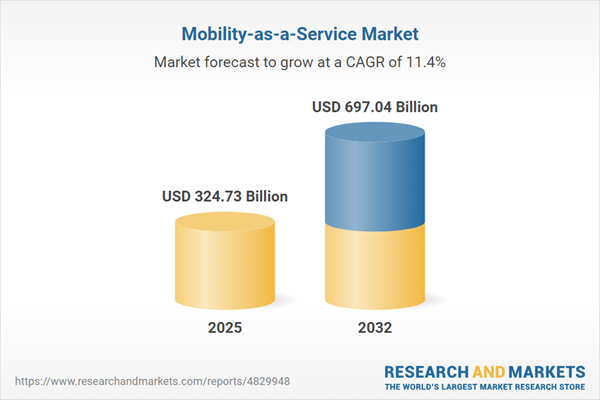Speak directly to the analyst to clarify any post sales queries you may have.
The Mobility-as-a-Service market is evolving as digital platforms, technology advancements, and changing transportation habits reshape how users engage with urban mobility solutions. Forward-thinking organizations now seek actionable insights to capture new opportunities in this dynamic sector.
Market Snapshot: Mobility-as-a-Service Market Size and Growth Trajectory
The Mobility-as-a-Service market grew from USD 292.84 billion in 2024 to USD 324.73 billion in 2025, and is forecasted to reach USD 697.04 billion by 2032, at a CAGR of 11.44%. This upward trend reflects robust demand for integrated, user-centric mobility platforms as businesses and consumers embrace multi-modal, convenience-driven transportation solutions.
Scope & Segmentation
This report delivers comprehensive coverage using a rigorous approach to mobility-as-a-service market segmentation:
- Service Types: Bike rental, car rental (long-term, short-term, daily, hourly), public transit integration, ride-sharing, shuttle services (fixed, on-demand), and taxi services
- Payment Models: Pay-as-you-go and subscription-based systems
- Provider Types: Aggregator platforms and independent service providers
- Vehicle Types: Buses, four-wheelers, micro-mobility options, and trains
- Commuting Patterns: Inter-city and intra-city user journeys
- Propulsion Types: Electric vehicles, fuel cell vehicles, hybrids, and internal combustion engines
- Business Models: Business-to-business, business-to-consumer, and peer-to-peer arrangements
- End Users: Business organizations (including business travel and corporate commutes), individual consumers (commuters and tourists), and the public sector
- Regions: Americas (North and Latin America), Europe, Middle East & Africa (EMEA), and Asia-Pacific, with further detail by key national markets
- Leading Companies: Analysis includes ANI Technologies Private Limited, Beep, Inc., Bird Rides, Inc., Bolt Technology OÜ, Bridj Technology Pty Ltd., Cabify España, S.L., Comuto SA, Cubic Corporation, Daihatsu Motor Co., Ltd. by Toyota Motors, Daimler AG, Flix SE, FOD Mobility Group, Free2move by Stellantis, GATEWAY DIGITAL, Grab Holdings Limited, inDrive by SUOL INNOVATIONS LTD, Intellias LLC, Lyft, Inc., Marsh LLC, MOOVEL NORTH AMERICA, LLC by Strategic Mapping Inc., MVIN Carco 1 Private Limited, QPo Cabs by Unovay Technologies Private Limited, Ridecell, Inc., Siemens AG, SkedGo Pty Limited, SWARCO AG, Trafi Ltd., TRANSDEV Group, Uber Technologies, Inc., Via Transportation, Inc., Volkswagen AG, Yulu Bikes Pvt. Ltd. by Bajaj Auto, Zipcar, Inc. by Avis Budget Group, and Zoomcar Holdings Inc
Key Takeaways for Senior Decision-Makers
- Integrated digital mobility services attract urban and regional users by combining ride-sharing, public transit, car rentals, and micro-mobility offerings within unified interfaces.
- Advancements in connected vehicle technology, data analytics, and artificial intelligence enable providers to deliver personalized trip planning and adaptive routing for corporate and consumer segments.
- Regulatory change, including incentives for low-emission mobility and open data protocols, fosters an environment where partnerships between automotive, tech, and transit sectors accelerate innovation and service reach.
- Businesses are increasingly leveraging dynamic pricing, tiered subscriptions, and bundled mobility solutions to meet evolving user expectations for flexibility, convenience, and sustainability.
- Asia-Pacific, EMEA, and the Americas each present unique regulatory, infrastructure, and consumer adoption patterns, requiring localized strategies for providers entering or expanding in these diverse regions.
Tariff Impact and Cost Structures
The introduction of new United States tariffs in 2025 will pressure supply chain resiliency and elevate procurement costs for mobility-as-a-service providers. Senior leaders must develop multi-sourcing strategies, engage proactively with regulatory shifts, and leverage analytics to manage cost pass-through and customer retention challenges. Collaboration within trade associations and strategic partnerships will be essential to maintain operational agility during periods of tariff-related volatility.
Methodology & Data Sources
This report synthesizes data collected via interviews with executives, regulators, and industry authorities, complemented by secondary research from journals, public filings, and validated news sources. Quantitative market data is corroborated by cross-source triangulation, rigorous normalization, and expert panel review to ensure strategic reliability and actionable insights.
Why This Report Matters
- Enables strategic planning for integrated, user-driven service models in urban and regional mobility markets
- Supports data-backed investment decisions through segment-level and regional analysis, benchmarking key players and innovations
- Equips stakeholders to anticipate regulatory change, adapt sourcing strategies, and identify high-growth avenues for sustainable competitive advantage
Conclusion
The Mobility-as-a-Service market continues to transform as technologies, business models, and public policy evolve. Leaders adopting flexible, data-driven approaches will be best positioned to capture demand and deliver differentiated user experiences. Use these insights to shape informed strategy in a rapidly advancing ecosystem.
Additional Product Information:
- Purchase of this report includes 1 year online access with quarterly updates.
- This report can be updated on request. Please contact our Customer Experience team using the Ask a Question widget on our website.
Table of Contents
3. Executive Summary
4. Market Overview
7. Cumulative Impact of Artificial Intelligence 2025
Companies Mentioned
The companies profiled in this Mobility-as-a-Service market report include:- ANI Technologies Private Limited
- Beep, Inc.
- Bird Rides, Inc.
- Bolt Technology OÜ
- Bridj Technology Pty Ltd.
- Cabify España, S.L.
- Comuto SA
- Cubic Corporation
- Daihatsu Motor Co., Ltd. by Toyota Motors
- Daimler AG
- Flix SE
- FOD Mobility Group
- Free2move by Stellantis
- GATEWAY DIGITAL
- Grab Holdings Limited
- inDrive by SUOL INNOVATIONS LTD
- Intellias LLC
- Lyft, Inc.
- Marsh LLC
- MOOVEL NORTH AMERICA, LLC by Strategic Mapping Inc.
- MVIN Carco 1 Private Limited
- QPo Cabs by Unovay Technologies Private Limited
- Ridecell, Inc.
- Siemens AG
- SkedGo Pty Limited
- SWARCO AG
- Trafi Ltd.
- TRANSDEV Group
- Uber Technologies, Inc.
- Via Transportation, Inc.
- Volkswagen AG
- Yulu Bikes Pvt. Ltd. by Bajaj Auto
- Zipcar, Inc. by Avis Budget Group
- Zoomcar Holdings Inc
Table Information
| Report Attribute | Details |
|---|---|
| No. of Pages | 198 |
| Published | November 2025 |
| Forecast Period | 2025 - 2032 |
| Estimated Market Value ( USD | $ 324.73 Billion |
| Forecasted Market Value ( USD | $ 697.04 Billion |
| Compound Annual Growth Rate | 11.4% |
| Regions Covered | Global |
| No. of Companies Mentioned | 35 |









